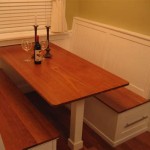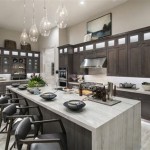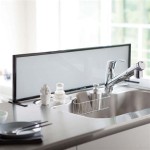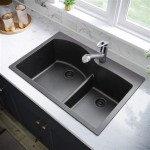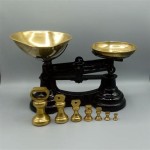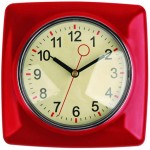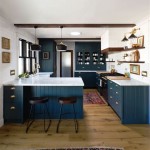How Deep Are Top Kitchen Cabinets?
Understanding the standard dimensions of kitchen cabinets is crucial for both remodeling projects and new construction. While the height and width of cabinets often receive significant attention, the depth of top, or wall, cabinets also plays a critical role in kitchen functionality and aesthetics. Neglecting this aspect can result in an inefficient workspace or an aesthetically unbalanced design. This article will explore the standard depths of top kitchen cabinets, the factors that influence these dimensions, and the implications of varying depths on kitchen design and usability.
Top kitchen cabinets, also known as wall cabinets or upper cabinets, are typically mounted on the wall above the countertop. Their primary purpose is to provide storage space for dishes, glassware, food items, and other kitchen essentials. The depth of these cabinets directly affects the amount of storage they offer and the accessibility of the items stored within. Understanding the standard depths helps homeowners, designers, and contractors plan a kitchen layout that is both functional and visually appealing.
The standard depth for top kitchen cabinets is generally 12 inches (30.48 cm). This dimension is considered a baseline for several reasons, primarily relating to ergonomics and the dimensions of common kitchen items. However, cabinets can vary in depth, and understanding these variations is essential for proper kitchen design and planning.
The Standard 12-Inch Depth: Rationale and Benefits
The 12-inch depth has become the industry standard for top kitchen cabinets largely due to ergonomic considerations. It allows most users to comfortably reach items stored inside without straining. A deeper cabinet would require more reaching, potentially leading to back strain or difficulty accessing items at the back of the shelf. The depth also complements the standard countertop depth, ensuring a balanced and functional workspace.
Another key factor influencing the 12-inch standard is the size of typical kitchen items. Plates, bowls, glasses, and food containers generally fit comfortably within a 12-inch deep cabinet. This depth allows for efficient storage without wasting space. It's a practical compromise between maximizing storage capacity and maintaining accessibility.
From a design perspective, the 12-inch depth also contributes to a visually balanced kitchen. It prevents the upper cabinets from overpowering the lower cabinets and countertop. This balance is essential for creating a harmonious and aesthetically pleasing kitchen environment. The depth ensures that the upper cabinets do not protrude too far into the workspace, allowing for comfortable movement and preventing a cramped feeling.
Furthermore, the 12-inch dimension simplifies installation. It's a widely available size, making it easier to find cabinets that meet the standard. This also helps reduce installation costs as contractors are familiar with working with this dimension.
Factors Influencing Top Cabinet Depth
While 12 inches is the standard, several factors can influence the depth of top kitchen cabinets. These factors often depend on the specific needs of the homeowner, the design of the kitchen, and the available space. Variations in depth are often used to accommodate specific storage needs or to create a unique aesthetic.
Kitchen Size and Layout:
The size and layout of the kitchen play a significant role in determining cabinet depth. In smaller kitchens, maximizing storage space is often a priority. Therefore, deeper cabinets might be considered, although care must be taken to ensure adequate workspace and comfortable movement. In larger kitchens, a greater variety of depth options can be considered to create visual interest and customize storage solutions. An island, for example, might have deeper cabinets on one side to accommodate specific appliances or oversized items.Storage Needs:
The specific storage needs of the homeowner are a crucial consideration. If a homeowner has a large collection of oversized platters or baking sheets, deeper cabinets might be necessary to accommodate these items. Conversely, if the homeowner primarily uses smaller dishes and containers, shallower cabinets might suffice, freeing up space and creating a more open feel. The type and quantity of items to be stored should be carefully considered when selecting cabinet depth.Appliance Integration:
The integration of appliances, such as microwaves or range hoods, can also influence cabinet depth. Cabinets above these appliances often need to be deeper to accommodate the appliance's dimensions and ensure proper ventilation. The depth of these cabinets must be carefully coordinated with the appliance's specifications to ensure a seamless and functional design. The chosen appliance's installation requirements are paramount when planning cabinet dimensions.Aesthetic Considerations:
Aesthetic preferences can also influence cabinet depth. Some homeowners prefer a more streamlined and minimalist look, opting for shallower cabinets to create a cleaner and more open space. Others might prefer deeper cabinets to create a more traditional and substantial feel. The desired aesthetic should be carefully considered when selecting cabinet depth to ensure a cohesive and visually appealing kitchen design. The overall style of the kitchen, whether modern, traditional, or transitional, will influence the choice of cabinet dimensions.Accessibility Requirements:
For individuals with mobility limitations, accessibility is a critical consideration. Shallower cabinets might be preferred to ensure that items are within easy reach. Adjusting the height and depth of cabinets can significantly improve accessibility and usability for individuals with disabilities. Consider installing pull-down shelving systems within the cabinets to improve access to upper shelves.Impact of Varying Depths on Design and Usability
Varying the depth of top kitchen cabinets can have a significant impact on both the design and usability of the kitchen. Understanding these implications is crucial for making informed decisions about cabinet selection and placement. Strategic use of varying depths can enhance functionality, improve aesthetics, and optimize storage space.
Enhanced Functionality:
Deeper cabinets can provide additional storage space for larger items, while shallower cabinets can improve accessibility for smaller items. Combining different depths strategically can optimize functionality and create a more efficient workspace. For example, a deep cabinet above the refrigerator can accommodate large serving bowls, while a shallow cabinet near the stove can store frequently used spices and oils. Proper planning of storage zones and the items to be stored within each zone is crucial for maximizing functionality.Improved Aesthetics:
Varying cabinet depths can add visual interest and break up the monotony of a uniform design. This can be particularly effective in larger kitchens where a more dynamic and layered look is desired. By incorporating cabinets of different depths, a designer can create a sense of depth and dimension, preventing the kitchen from feeling flat or characterless. The strategic placement of different cabinet depths can highlight focal points and create a more visually engaging space.Optimized Storage Space:
By carefully considering the items to be stored in each cabinet, the homeowner can optimize storage space and minimize wasted space. Shallow cabinets can be used to store smaller items, preventing them from getting lost in the back of a deep cabinet. Deeper cabinets can accommodate larger items, maximizing storage capacity. Analyzing the inventory of kitchen items and planning the storage layout accordingly is essential for efficient space utilization.Ergonomic Considerations:
While deeper cabinets offer more storage, they can also make it more difficult to reach items at the back. It's important to strike a balance between storage capacity and accessibility, considering the user's reach and mobility. Pull-out shelves and other storage accessories can help improve accessibility in deeper cabinets. The ergonomic principles of reach zones and frequency of use should guide the placement of cabinets of different depths.Cost Implications:
Deeper cabinets generally require more materials and labor to manufacture, which can increase their cost. It's important to consider the budgetary implications of varying cabinet depths and to weigh the benefits against the cost. While customization can be appealing, sticking to standard depths can help control costs without sacrificing functionality. Obtaining quotes from multiple cabinet manufacturers and comparing prices is recommended to ensure a cost-effective solution.In conclusion, while 12 inches serves as the standard depth for top kitchen cabinets, understanding the factors that influence these dimensions and the implications of varying depths on design and usability is paramount. Considering kitchen size, storage needs, appliance integration, aesthetic preferences, and accessibility requirements allows for informed decisions regarding cabinet selection and placement. This ensures that the resulting kitchen is both functional and aesthetically satisfying, meeting the specific needs and preferences of the homeowner.

Standard Kitchen Counter Depth Hunker Cabinet Dimensions Cabinets Height

How To Decide Between Upper Kitchen Cabinets Open Storage And More

Get More Kitchen Storage With Counter Depth Upper Cabinets

Standard Kitchen Cabinet Dimensions For Your Homee Design Cafe

How High Upper Cabinets Should Be From Your Floor And Countertop

A Guide To Standard Kitchen Cabinet Sizes And Dimensions 2024

11 Times You Should Hang Your Upper Kitchen Cabinets Higher

What To Know About Installing Kitchen Cabinets And Drawers Remodeling 101 Remodelista

Kitchen Cabinet Sizes What Are Standard Dimensions Of Cabinets

How High Upper Cabinets Should Be From Your Floor And Countertop
Related Posts

